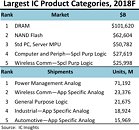Raevenlord
News Editor
- Joined
- Aug 12, 2016
- Messages
- 3,755 (1.16/day)
- Location
- Portugal
| System Name | The Ryzening |
|---|---|
| Processor | AMD Ryzen 9 5900X |
| Motherboard | MSI X570 MAG TOMAHAWK |
| Cooling | Lian Li Galahad 360mm AIO |
| Memory | 32 GB G.Skill Trident Z F4-3733 (4x 8 GB) |
| Video Card(s) | Gigabyte RTX 3070 Ti |
| Storage | Boot: Transcend MTE220S 2TB, Kintson A2000 1TB, Seagate Firewolf Pro 14 TB |
| Display(s) | Acer Nitro VG270UP (1440p 144 Hz IPS) |
| Case | Lian Li O11DX Dynamic White |
| Audio Device(s) | iFi Audio Zen DAC |
| Power Supply | Seasonic Focus+ 750 W |
| Mouse | Cooler Master Masterkeys Lite L |
| Keyboard | Cooler Master Masterkeys Lite L |
| Software | Windows 10 x64 |
The DRAM market is expected to increase in value some 30% this year, in wake of increased demand and parts shortage due to less-than-adequate production ramp-up to keep up with the demands of modern systems integrators. Doing this, its value will jump to more than $100 Billion in value, marking the first time a semiconductor product category ever surpasses that mark. The 30% increase in value joins an accumulated 78% increase that already occurred in 2017 - a twofold increase in just two years. Who said anything about cryptocurrency having massive increases in value?
IC Insights expects this $100 Billion threshold to be passed this year (a 39% growth), while IBS projects it to only be surpassed by 2019, with a 32% growth for 2018. Still, that's a small differing window which matters little in the grand scheme of things.



View at TechPowerUp Main Site
IC Insights expects this $100 Billion threshold to be passed this year (a 39% growth), while IBS projects it to only be surpassed by 2019, with a 32% growth for 2018. Still, that's a small differing window which matters little in the grand scheme of things.



View at TechPowerUp Main Site


